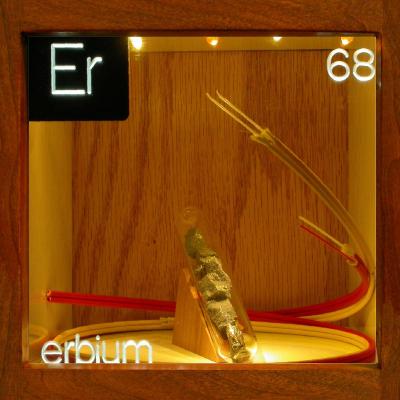Home Size: 1 2 3 4 5 6 7 8 9
|
 |
| A bright, silvery lanthanide metal which is relatively stable in dry air. It finds application in producing optical fibres.
|
|
|
 |
Lumps ampouled under argon.
These pieces of erbium metal are protected under an argon atmosphere in the ampoule. As is the case with many of the rare earths, erbium slowly oxidizes in the air becoming covered in a white oxide powder. Although the element was first isolated in the 19th Century, it was not until 1934 that a sample of the pure metal was obtained. And it has only been in the past decade that relatively large chunks like this have become commercially available.
Source: China
Size: 0.75"
Purity: 99%
|
|
 |
Optical fibers.
These fibre optic cables have been doped with erbium oxide. In other words, the molten glass from which the fibres have been drawn has had a small percentage of erbium oxide mixed in. As a result, the fibres acquire the ability to amplify light signals that are send down them, making reliable communication possible over much longer distances than with plain glass. Strictly speaking, the erbium does not amplify the light but rather it concentrates the energy in light spread out over the spectrum into sharp peak at a specific frequency. Since light tends to spread out as it travels down the fibre, this offers a way to sharpen the signal and extend the range. It is an astonishing fact that a single fibre optic cable, like the ones you see here, is theoretically capable of transmitting simultaneously the entire bandwidth of all the radio. TV and telephone signals currently broadcast.
Source: donated by [ALICIA]
Size: various lengths up to10 feet
Purity: n/a
|
|
|

